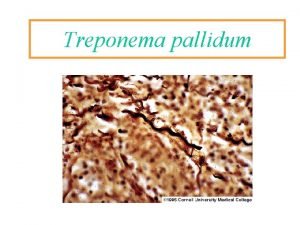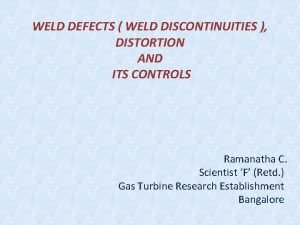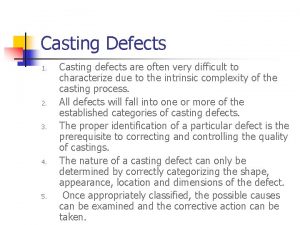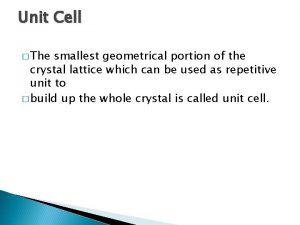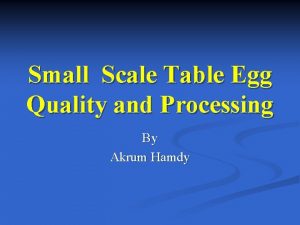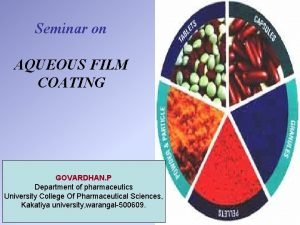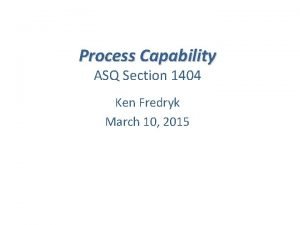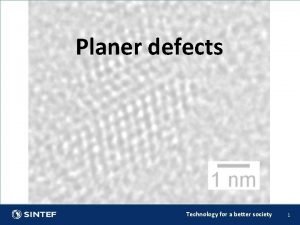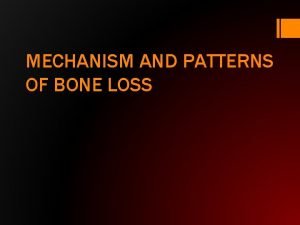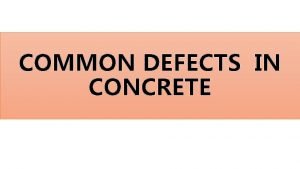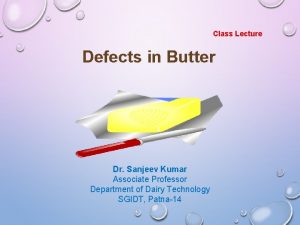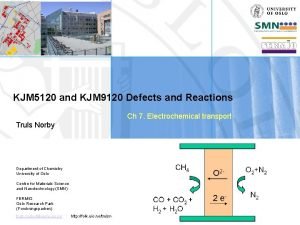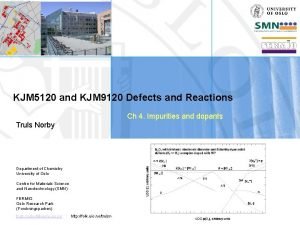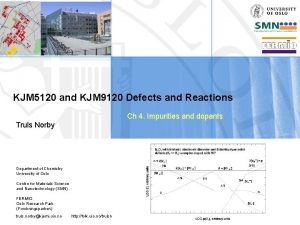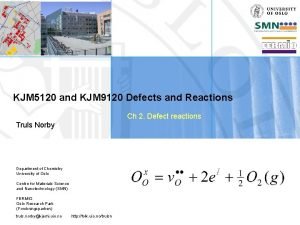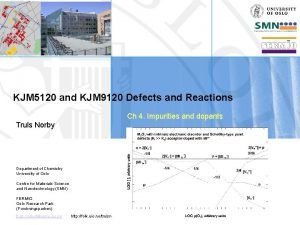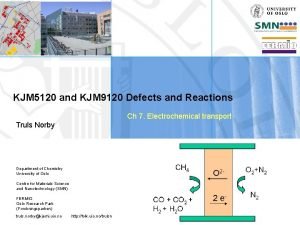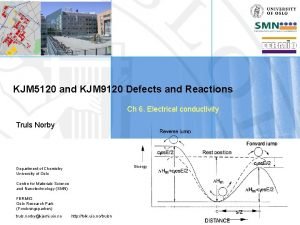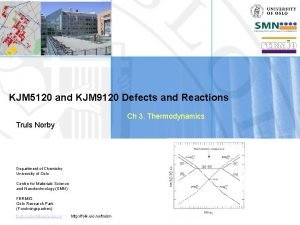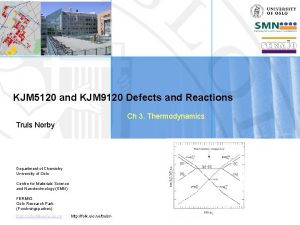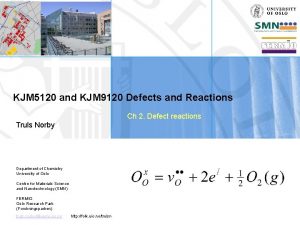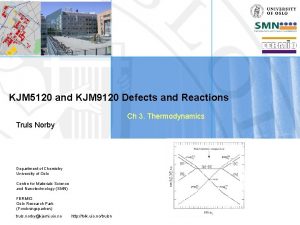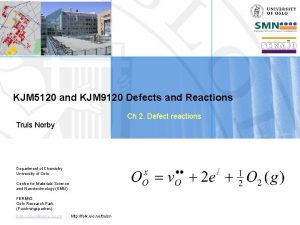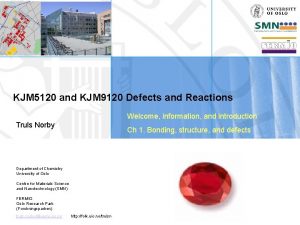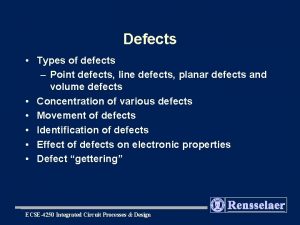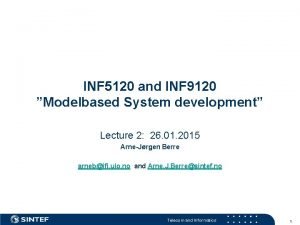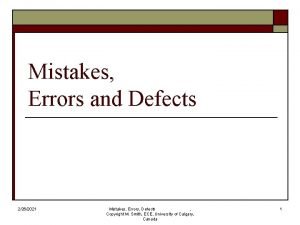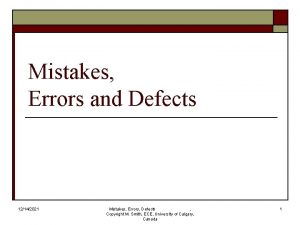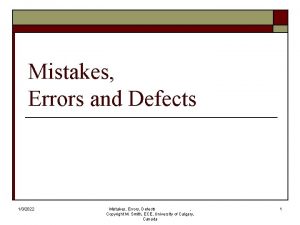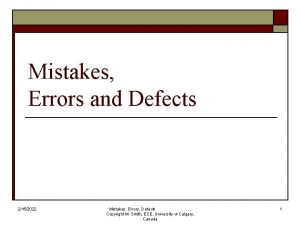KJM 5120 and KJM 9120 Defects and Reactions


























- Slides: 26

KJM 5120 and KJM 9120 Defects and Reactions Ch 6. Electrical conductivity Truls Norby Energy Department of Chemistry University of Oslo Centre for Materials Science and Nanotechnology (SMN) FERMIO Oslo Research Park (Forskningsparken) truls. norby@kjemi. uio. no http: //folk. uio. no/trulsn

Electrical conductivity – before we begin… • In this chapter we will see what happens when we apply an electrical field to mobile charged species. • From this we will obtain an expression and definition of conductivity. • The conductivity is the proportionality between electrical field and current density (Ohm’s law). • We will see that the factors of conductivity are the charge, concentration and mobility of the charge carriers. • For atoms and ions, the mobility relates directly to the random diffusivity. • For electronic defects, transport may comprise mechanisms different than random diffusion.

Force and flux density in an electrical field • An electrical field (in one dimension) is the downhill gradient in electrical potential: • It gives rise to a force on charged particles given as • We have seen earlier that a force Fi exerted on particles i gives rise to a drift velocity vi which is proportional to the mechanical mobility Bi: • The flux density after inserting the driving force of the electrical field:

Current density • The current density is the product of charge and flux density:

Mobilities and conductivity • We now define a charge mobility ui Charge mobility u is in physics often denoted μ. We here use u to avoid confusion with chemical potential. • We then obtain for the current density: • We now define conductivity σi Very important! Know it! • and obtain This is a version of Ohm’s law. Conductivity has units S/cm or S/m.

Partial and total conductivity; transport numbers • Total conductivity is the sum of the partial conductivities • The transport number is • Partial conductivities typically comprise cations, anions, electrons, holes: • Each ionic conductivity may have contributions from more than one defect mechanism. Conductivity from foreign species may contribute, notably protons. •

The Nernst-Einstein relation between mobility and diffusion coefficient • We have – from general considerations of transport in a force field earlier seen that • and, now, through introduction of charge mobility and conductivity: • • These are Nernst-Einstein relations. Now we will derive this in more detail based on random diffusion.

The Nernst-Einstein relation between mobility and diffusion coefficient We will consider an electrical field E superimposed on an energy landscape for randomly jumping charged particles Energy All the “ci”s in Kofstad’s figure should be “zi”s !

The Nernst-Einstein relation between mobility and diffusion coefficient The electrical field E changes the energy barrier in the forward and backward directions. The change depends on the potential difference (distance s x field E) and the charge zie. This changes the rate of forward and Energy reverse sufficiently energetic vibrations

The Nernst-Einstein relation between mobility and diffusion coefficient Flux densities: Energy

The Nernst-Einstein relation between mobility and diffusion coefficient Flux densities: For small zies. E << k. T, using ex – e-x ≈ 2 x for x <<1, we get

The Nernst-Einstein relation between mobility and diffusion coefficient • From earlier, • From this we may obtain the Nernst-Einstein relations: • or, inverted: • The following functions have the same temperature dependency as diffusivity:

Diffusion and mobility • We have considered diffusion and mobility of diffusing species • Applies to atoms and ions in solids, and deeply trapped electrons (and holes (small polarons) • Linear property if driving force not too big • Next we will consider electronic charge carriers • They may travel as free waves (itinerant) and then have drift mobilities, limited by collisions with phonons, impurities, or other defects or be shallowly trapped as large polarons or be deeply trapped as small polarons, whereby they migrate by diffusion

Non-polar solids; itinerant electrons • • High temperatures; Mobility dominated by lattice (phonon) scattering. Typical behaviour: un, latt = un, latt, 0 T-3/2 up, latt = up, latt, 0 T-3/2 • • Low temperatures; Mobility dominated by impurity (defect) scattering. Typical behaviour: un, latt = un, imp, 0 T+3/2 up, latt = up, imp, 0 T+3/2 • The total scattering has contributions from both:

Polar (ionic) oxides • Large (shallow) polarons Typical behaviour: ularge pol. = ularge pol. , 0 T-1/2 • Small (deep) polarons Activated diffusion of electrons or holes: Called Eu in the text • Note that electrons and holes may migrate by different mechanisms

From mobility to conductivity • Now we have the appropriate expressions of charge mobility • From Chapters 1 -4 we have expressions for defect concentrations • From earlier we have • Voila! • But shall we use defects or real species? You can choose – the conductivity is the same - but stick with your choice! • 1 st approximation: The concentration of the defect varies, but its mobility is constant The concentration of the constituent ion is constant, but the mobility varies

Intrinsic electronic semiconductors • Electronic conductors: Sum of n-type and p-type contributions: • From Ch. 3; Excitation of electrons and holes: • From Ch. 3; If intrinsic electronic excitation dominates: • Electronic conductivity in intrinsically excited semiconductor: Both NCNV and un+up may contain temperature dependencies, but the exponential Eg/2 dependence often dominates intrinsic semiconductors

Doped semiconductors • At not too low temperatures (k. T>>Ed, Ea) effectively all donors and acceptors are ionised • The concentration of electrons or holes is then constant and equal to the donor or acceptor concentration, respectively • Donor-doped semiconductor (n-type): • Acceptor-doped semiconductor (p-type): Temperature dependencies only from mobility

Typically, semiconductors have 3 temperature dependency regions • High temperatures – Intrinsic semiconduction (n + p type – Temperature dependency roughly determined by Eg/2 • Intermediate temperatures – n or p determined by donors or acceptors – Temperature dependency given by mobility terms only • Low temperatures – Dopants not effectively ionised – n or p given by ionisation of dopants – Temperature dependency has contributions from Ed or Ea and from mobility un or up

Conductivity in non-stoichiometric oxides • Consider an oxide with oxygen deficiency. From Ch. 3: • The total conductivity may be assumed to be • The mobility of electronic defects (here electrons) is normally orders of magnitude higher than that of point defects (here oxygen vacancies). • so that the conductivity is dominatedly n-type electronic:

p. O 2 dependency of the n-type conductivity of the oxygen deficient oxide • From previous slide: • Let’s take the logarithm: • Log conductivity vs log p. O 2 gives a straight line with slope -1/6 • An observed dependency like this would be characteristic for and thus used to identify the simplified electroneutrality at hand • Note the isobar (at constant p. O 2) for the next slide

Temperature dependency of the n-type conductivity of the oxygen deficient oxide • From previous slide: • Let us assume a small polaron hopping model for electrons: • Let’s take the logarithm: • An isobaric plot of log(σn. T) vs 1/T (Arrhenius plot) yields the activation energy. which has contributions from defect formation and mobility

Ionic conductivity; Example: Y-doped Zr. O 2 • If we acceptor dope Zr. O 2 -y with Y 2 O 3 (yttria stabilised zrconia, YSZ) we get • and the ionic conductivity due to oxygen vacancies becomes • This conductivity is independent of p. O 2 • A plot of ln(σv. O**T) vs 1/T yields the activation energy for mobility of oxygen vacancies from the slope

Three (or four) regions of temperature dependency for a doped ionic conductor • High temperatures – Intrinsic defect pair or non-stoichiometry dominate – Normally electronic conduction • Moderately high temperatures – Dopant and ionic defect dominate – But electronic defects significant, and their mobilities make them dominate conductivity • Moderately low temperatures – Dopant and ionic defect dominate – High ionic conductivity – Temperature dependency reflects activation energy of mobility of ionic defect • Low temperatures – Mobile defects trapped by dopants – Low ionic conductivity – Temperature dependency reflects both mobility of the defect and the trapping energy

From concentration properly to conductivity • The concentration in conductivity expressions must be a volume concentration: – #/unit volume (e. g. cm-3 or m-3) or (if e is replaced by F) – mol/unit volume (e. g. mol cm-3) • Thus, if the concentration is originally obtained from defect chemistry as site fraction or molar fraction, it must be converted to volume concentration by multiplying with the site density or molar density; generally: • Examples: – Site density cs obtained from number of sites per formula unit b times Z (number of formula units per unit cell) divided by unit cell volume Vu: cs = b * Z / Vu – Molar density obtained as mass density δ divided by molar mass Mm: Cm (mol/unit volume) = δ (mass/unit volume) / Mm (mass/mol) – Molar density is the inverse of molar volume Vm: Cm = 1 / V m

Correlation factor • The effective diffusion of a traceable ion (tracer) is not necessarily as large as that of a non-traceable one (or of charge itself): Dt = f D r where f ≤ 1 (depending on structure and diffusion mechanism) so that Dt ≤ Dr. • In intersticialcy diffusion, we have the additional action of a displacement factor S; ratio between charge displacement and tracer displacement: Dt = (f/S) Dr • f and S can be evaluated from ionic conductivity and Dt (Individual measurements or the Manning experiment) S=2
 Sifilide
Sifilide Section 2 reinforcement classifying chemical reactions
Section 2 reinforcement classifying chemical reactions Half redox reaction
Half redox reaction Section 2 reinforcement classifying chemical reactions
Section 2 reinforcement classifying chemical reactions Types of reactions
Types of reactions Unit 5 chemical reactions answers
Unit 5 chemical reactions answers Schottky and frenkel defects
Schottky and frenkel defects Excess weld reinforcement
Excess weld reinforcement Casting defect
Casting defect Distinguish between schottky defect and frenkel defect
Distinguish between schottky defect and frenkel defect Firmness of the yolk and freedom from yolk defects
Firmness of the yolk and freedom from yolk defects Execution defects
Execution defects Twinning tablet defects
Twinning tablet defects Explain the aims and objectives of mudaliar commission
Explain the aims and objectives of mudaliar commission Drop core
Drop core Chain sling defects
Chain sling defects Armany classification
Armany classification Process sigma calculator
Process sigma calculator Ppm formula
Ppm formula Planer defect
Planer defect Physical defects in personality development
Physical defects in personality development Bulbous bone contours
Bulbous bone contours Spina bifida
Spina bifida Upset in timber
Upset in timber Overlap gate injection molding
Overlap gate injection molding Concrete defects honeycomb
Concrete defects honeycomb Defects in butter
Defects in butter
